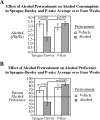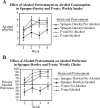Persistent high alcohol consumption in alcohol-preferring (P) rats results from a lack of normal aversion to alcohol
- PMID: 20356869
- PMCID: PMC2899945
- DOI: 10.1093/alcalc/agq020
Persistent high alcohol consumption in alcohol-preferring (P) rats results from a lack of normal aversion to alcohol
Abstract
Aims: In this study, we tested the impact of pretreatment with alcohol on subsequent alcohol drinking in outbred Sprague-Dawley and selectively bred alcohol-preferring (P) rats.
Methods: As a pretreatment, male Sprague-Dawley and P rats were given a passive oral administration of either alcohol (1.0 g/kg) or tap water. Then, they were given free choice of drinking alcohol (5% v/v) or water in their home cages, which was measured over 4 weeks.
Results: Without alcohol pretreatment, there was no significant strain difference in alcohol preference; both strains preferred 5% (v/v) alcohol solution. The strain difference was only apparent in the groups given alcohol pretreatment. This arose from the fact that alcohol pretreatment significantly reduced alcohol preference in the Sprague-Dawley rats to a level well below 50%, while it did not alter drinking behavior in P rats. The same effects were seen with total alcohol consumption (g/kg/day). These effects persisted throughout the 4 weeks of the study.
Conclusions: The principal difference between the Sprague-Dawley and P rats was that the P rats did not show the normal aversion to alcohol after forced exposure to alcohol that the Sprague-Dawley rats showed. One of the potential contributors to high alcohol intake and preference in P rats may be lack of sensitivity to aversive effects of alcohol.
Figures


Similar articles
-
Voluntary ethanol drinking during the first three postnatal weeks in lines of rats selectively bred for divergent ethanol preference.Alcohol Clin Exp Res. 1999 Dec;23(12):1892-7. Alcohol Clin Exp Res. 1999. PMID: 10630607
-
Early ethanol and water consumption: accumulating experience differentially regulates drinking pattern and bout parameters in male alcohol preferring (P) vs. Wistar and Sprague Dawley rats.Physiol Behav. 2014 Jan 17;123:20-32. doi: 10.1016/j.physbeh.2013.09.015. Epub 2013 Oct 2. Physiol Behav. 2014. PMID: 24095931 Free PMC article.
-
Early ethanol and water intake: choice mechanism and total fluid regulation operate in parallel in male alcohol preferring (P) and both Wistar and Sprague Dawley rats.Physiol Behav. 2014 Jan 17;123:11-9. doi: 10.1016/j.physbeh.2013.09.011. Epub 2013 Oct 2. Physiol Behav. 2014. PMID: 24095933 Free PMC article.
-
Orexin/hypocretin-1 receptor antagonism reduces ethanol self-administration and reinstatement selectively in highly-motivated rats.Brain Res. 2017 Jan 1;1654(Pt A):34-42. doi: 10.1016/j.brainres.2016.10.018. Epub 2016 Oct 19. Brain Res. 2017. PMID: 27771284 Free PMC article.
-
Phenotypic characterization of genetically selected Sardinian alcohol-preferring (sP) and -non-preferring (sNP) rats.Addict Biol. 2006 Sep;11(3-4):324-38. doi: 10.1111/j.1369-1600.2006.00031.x. Addict Biol. 2006. PMID: 16961762 Review.
Cited by
-
Ketamine Differentially Attenuates Alcohol Intake in Male Versus Female Alcohol Preferring (P) Rats.J Drug Alcohol Res. 2017;6:236030. doi: 10.4303/jdar/236030. Epub 2017 Jul 28. J Drug Alcohol Res. 2017. PMID: 29416900 Free PMC article.
-
Sex-specific tonic 2-arachidonoylglycerol signaling at inhibitory inputs onto dopamine neurons of Lister Hooded rats.Front Integr Neurosci. 2013 Dec 19;7:93. doi: 10.3389/fnint.2013.00093. eCollection 2013. Front Integr Neurosci. 2013. PMID: 24416004 Free PMC article.
-
Braking dopamine systems: a new GABA master structure for mesolimbic and nigrostriatal functions.J Neurosci. 2012 Oct 10;32(41):14094-101. doi: 10.1523/JNEUROSCI.3370-12.2012. J Neurosci. 2012. PMID: 23055478 Free PMC article. Review.
-
Adolescent alcohol binge drinking and withdrawal: behavioural, brain GFAP-positive astrocytes and acute methamphetamine effects in adult female rats.Psychopharmacology (Berl). 2024 Aug;241(8):1539-1554. doi: 10.1007/s00213-024-06580-2. Epub 2024 May 6. Psychopharmacology (Berl). 2024. PMID: 38705893 Free PMC article.
-
Effects of ethanol, naltrexone, nicotine and varenicline in an ethanol and nicotine co-use model in Sprague-Dawley rats.Drug Alcohol Depend. 2020 Jul 1;212:107988. doi: 10.1016/j.drugalcdep.2020.107988. Epub 2020 Apr 25. Drug Alcohol Depend. 2020. PMID: 32387915 Free PMC article.
References
-
- Colombo G. Ethanol drinking behavior in Sardinian alcohol preferring rats. Alcohol Alcohol. 1997;32:443–53. - PubMed
-
- Eriksson K. Genetic section for voluntary alcohol consumption in the Albino rat. Science. 1968;159:739–41. - PubMed
-
- Froehlich JC, Harts J, Lumeng L, Li TK. Differences in response to the aversive properties of ethanol in rats selectively bred for oral ethanol preference. Pharm Biochem Behav. 1988;31:215–22. - PubMed
-
- Kurtz DL, Stewart RB, Zweifel M, et al. Genetic difference in tolerance and sensitization to the sedative/hypnotic effects of alcohol. Pharm Biochem Behav. 1996;53:585–91. - PubMed
-
- Li TK, Lumeng L, Doolittle DP. Selective breeding for alcohol preference and associated responses. Behav Genet. 1993;23:163–70. - PubMed
Publication types
MeSH terms
Substances
Grants and funding
LinkOut - more resources
Full Text Sources
Medical
Research Materials
Miscellaneous

